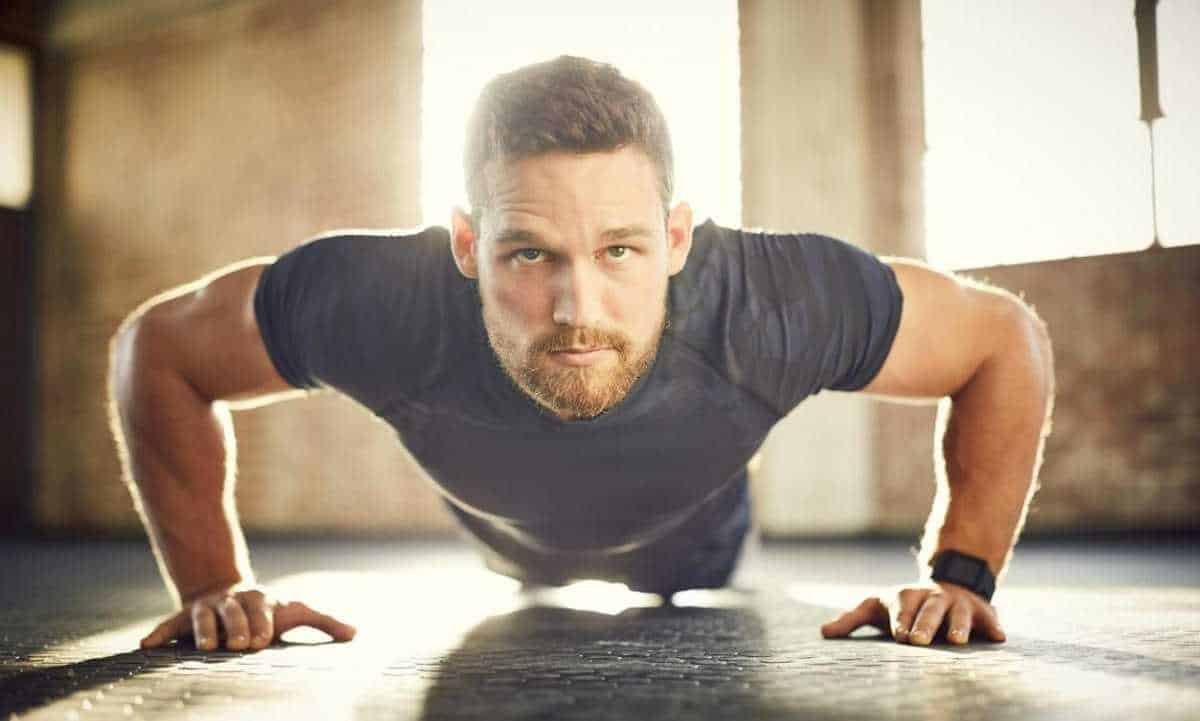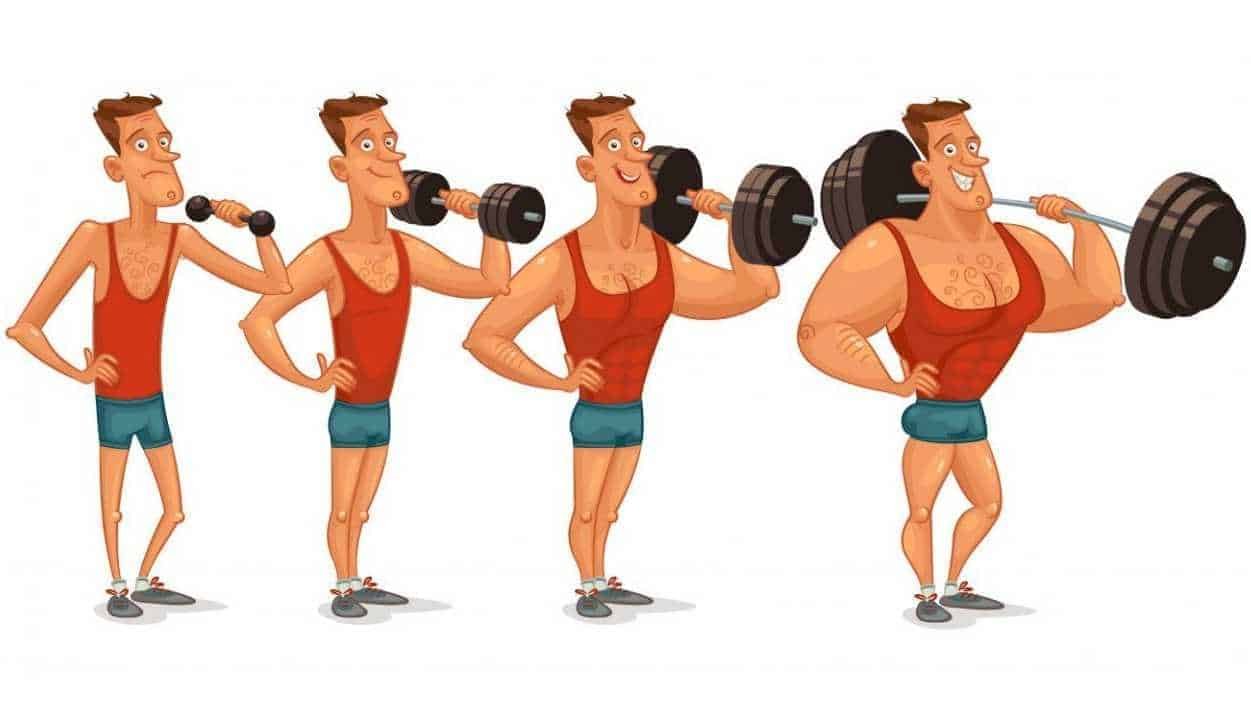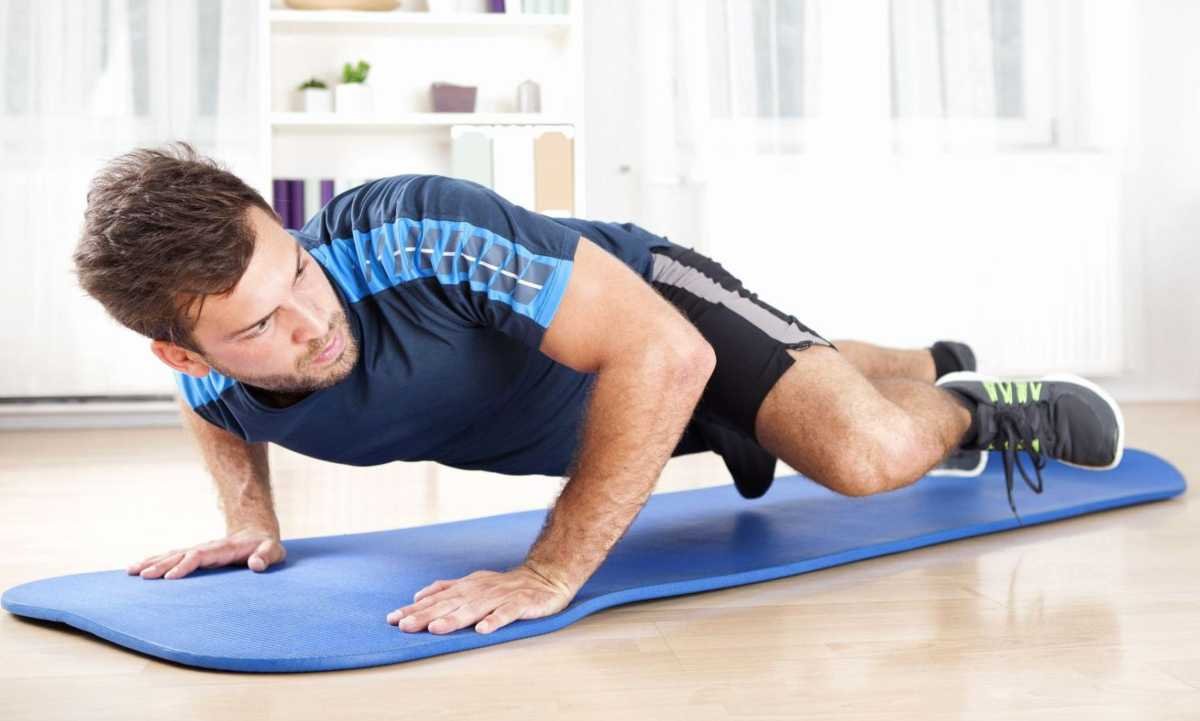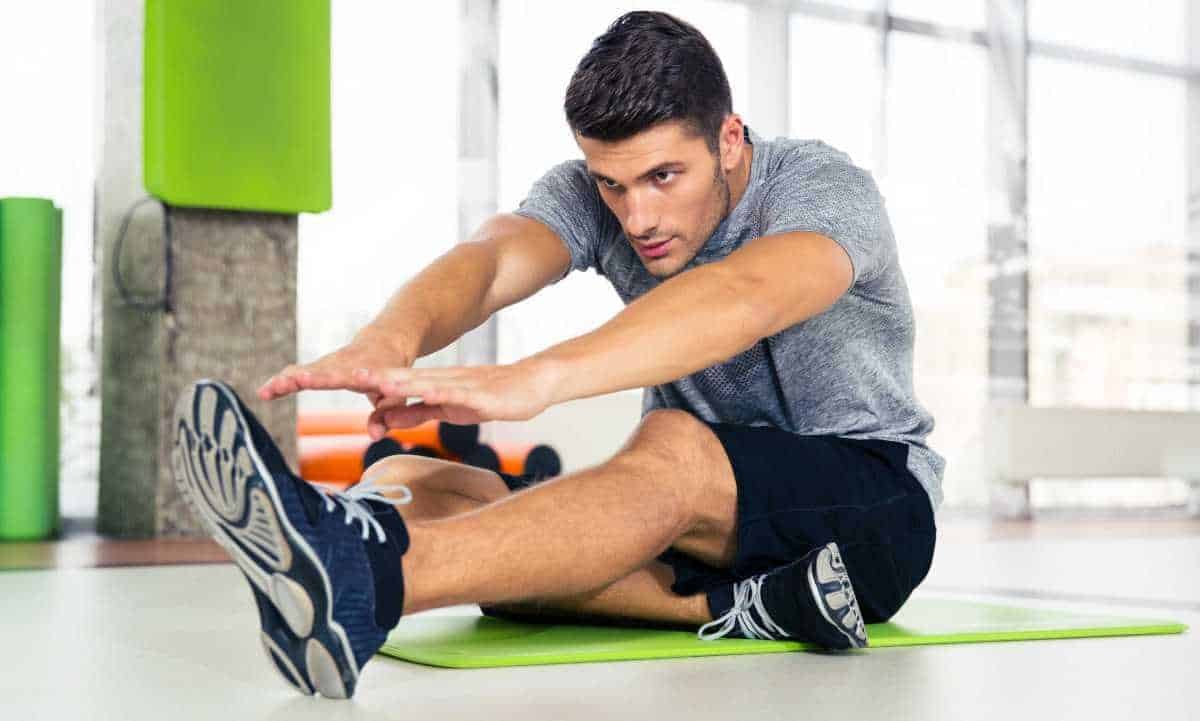These easy and convenient at home workouts for men don’t require weights and are simple to execute.
Feel Your Prime is the most important cornerstone of Too Manly. As a man, you must continuously train your body and mind to optimal levels so that you feel your best anytime, anywhere, and in any situation, and this requires exercise.
Unfortunately, most men are not up to the challenge. Instead of actively finding ways to keep their body in shape, they come up with many excuses for not exercising. I’m too tired, I’m too busy, I’m too overweight, my gym is too far, so on and so forth .
Does this sound like you? If so, it’s time to get your act together!
Not only is exercise one of the best things you can do for your health, but it’s something that can be easily incorporated into any lifestyle. You don’t need to buy a gym membership or even sophisticated equipment to get started, and you don’t have to spend hours doing it.
Heck, you could do a workout right now at this very moment if you wanted. Just get off your chair, find a little space, and give yourself a few moments.
Indeed, there are so many enjoyable fat burning, muscle building at home workouts for men that are quick, easy and downright effective.
IN THIS GUIDE
Progressive Overload And Working Out At Home
The human body will not change unless it’s forced to. If you want to gain muscle and improve your muscular endurance, you must make your muscles work harder and harder on a continuous basis.
The principle of gradually increasing the stress on your muscles to continually make gains in muscle size, strength, and endurance is called Progressive Overload. It involves continuously increasing the volume, intensity, frequency, or time of your workouts in order to achieve the desired results.
Ways To Increase Muscle Overload
Here are the five key ways you can progressively overload your muscles:
- Increase the resistance: Placing more load (weight) on your muscles. If curling 25 pounds is too easy for you, try curling 30-35 pounds instead
- Increase the reps: Instead of increasing the load on your muscles as you get stronger, you can simply do more repetitions. If doing 5 reps has become too easy, go for 8, 10, and then 12 reps before increasing the resistance
- Increase the volume: Increasing the amount of exercise you do in a set period of time. Incorporating more sets into your routine, either by doing more exercises or adding more sets to existing exercises, progressively overloads your muscle tissue
- Increase training frequency: The more times you workout your muscles in a week, the more they are stimulated to grow
- Decrease resting period: Reducing your rest interval between sets allows you to do the same amount of work in less time, therefore placing more stress on your muscles
This is just a general overview of progressive overload. Seeing as most homes don’t have the array of exercise equipment and weights that most gyms provide, serious resistance training is not an option.
That means all at home workouts for men need to be tailored around the other four methods of achieving progressive overload.
4 Key Principles For At Home Workouts
To get the best results from your home workouts, professional bodybuilders and coaches generally recommends that you follow four general principles.
- Do 3-5 Full Body Workouts Per Week
- Do 1-2 Exercises Per Body Part
- Do 3-4 Sets Per Exercise
- Train Close To Failure
When the only form of resistance you have is your bodyweight, you have to go to extremes to challenge your muscles. With these principles, the lack of weights for muscle resistance is compensated for by dialing up muscle overload through increased reps and training volume (i.e. an emphasis on full-body workouts than on isolation exercises).
We recommend that you follow these principles for all the at home workouts for men highlighted in this guide.
20 Fat Burning, Muscle Building At Home Workouts for Men
It’s time to get moving. With your own body weight, the help of gravity, and some determination, even the busiest men can build muscle and obliterate calories in the comfort of his living room, garage, or backyard in no time.
List below is a collection of the best at home workouts for men who genuinely want to feel their prime anytime, anywhere, and in any situation.
Upper Body Home Exercises For Men – No-Weights
The beauty of these workouts is that they don’t require weights. They are bodyweight exercises that target your upper body muscles, namely the chest, shoulders, triceps, and abs.
To really get your muscle bulging and your fat burning, select three or four of these exercises and repeat them one after the other as many times as possible in 20 minutes.
Standard Push Ups
No at home workout regimen is complete without push ups. They are one of the best equipment-less exercises you can do, not only because they work a lot of your muscles at the same time, but also because of their many different variations and progressions.
You can make the workout easier by doing inclined or knee push ups, or more difficult by doing side-to-side, archer, or one-armed push ups. This guide focuses on the standard two-arm push ups.
- Primary muscle groups: Chest, Triceps, Deltoids
- Secondary muscles: Biceps, Abs, Quadriceps, Erector Spinae
How to do Push Ups
- Begin by placing your chest and stomach flat on the floor, with your legs straight out behind you
- Place your palms at chest level, with the arms bent out at a 45-degree angle
- Exhale as you push from your hands and heels, bringing your chest, torso, and thighs off the ground without bending or arching your back
- Pause for a second in the plank position while keeping your core engaged
- Inhale as you slowly lower yourself back to the starting position, hovering over the floor without touching it with your chest, torso, and thighs
Repeat
Push ups are an at home workout every man should strive to do everyday.
Goal: 100 reps or more in total throughout the day.
Chest Dips
Generally considered the upper body squat, dips are another push-focused exercise that targets most of the same muscle groups as push ups.
- Primary muscles: Chest, Triceps, Deltoids, Rhomboids
- Secondary muscles: Traps (stabilizer), Biceps, Abs, Quadriceps
How to do Chest Dips
To do dips, you will need sturdy chairs or other objects (table, counter, etc.) with the same height and enough space between your wrists and the ground.
- Place your palms firmly on top of the evenly elevated parallel platform, making sure they are shoulder-width apart
- Slowly raise yourself up without locking your elbow in an upright position. If possible, have your legs raised at a 90 degree angle; otherwise, have them tucked under you
- Steadily dip yourself lower, with your body leaning slightly forward to ensure that your chest muscles get worked
- Raise yourself up as in step 2, and repeat
Note: Dips are one of the most difficult at home workouts for men who recently started exercising. If you find lifting your entire body off the ground to be too challenging, try doing the dips with your feet on the ground.
Goal: 3 sets of 10 reps. Gradually work your way up to 50 reps per session.
Tricep Dips
A basic bodyweight exercise, triceps dips, unlike the chest dip, shift the focus away from the chest to the triceps.
- Primary muscles: Triceps
- Secondary muscles: Chest, Anterior Deltoid, Pects, Rhomboids, Levator Scapulae Lats, Lower Traps
How to do Tricep Dips
Find a stable chair, bench, or step, and follow these steps:
- Sit on the edge of the chair and grip the edge next to your hips. Have your fingers pointing at your feet, legs extended, and feet approximately hip-width apart, with the heels touching the ground. Look straight ahead
- Press down with your palms to lift your body, and slide forward just far enough that your back side clears the edge of the chair
- Lower yourself until your elbows are bent between 45 and 90 degrees
- Slowly push yourself back up to the start position, and repeat
Goal: 3 sets of 10 reps. Gradually work your way up to 50 or more reps per session.
Bodyweight Tricep Extensions
A triceps extension is a push-type, isolation exercise that mostly works your triceps, though it also trains other parts of the body depending on the technique used.
- Primary muscles: Triceps
- Secondary muscles: Forearms, Lats
How to do bodyweight tricep extensions
- Start out in a position similar to a regular push-up, but with your arms extended out farther in front
- As you bend your elbows, slowly lower your body until your forearms elbows touch the ground
- Press down into the ground to push the body back up to the starting point. Repeat
It’s amazing how much strength this exercise requires from your triceps. As with all the exercises on this list, it’s important that you keep control and proper form!
Goal: 3 sets of 5-15 reps
Straight Leg Sit-Ups And Twists
Straight leg sit-ups can be difficult for beginners, especially those with a bit of a belly. However, as with all exercises, it gets easier the more you do them.
- Primary muscles: Abs, Obliques, rectus femoris
- Secondary: Neck flexors, chest muscles, and shoulder extensors
How you do Straight Leg Sit-Ups & Twists
- Begin by lying down on your back; straighten your legs, with your feet slightly wider than your shoulders; and put your hands behind your head
- Point your right arm straight up into the air, lift and twist your body off the ground using your stomach muscles as you reach to touch your left foot
- Untwist, return to starting position, and repeat using your left hand to touch your right foot
Goal: 3 sets of 8 to 10 reps on each side.
Standard Plank
Like push ups, planks are one of the simplest and most effective at home workouts for men and women of all ages.
The standard plank is the basis of many compound exercises. Even though it’s an isometric core strength exercise, it works other parts of the body.
- Primary muscles: Abs, Erector Spinae, Transverse Abdominis (TVA)
- Secondary muscles: Traps, Rhomboids, Rotator Cuff, The Anterior, Delts, Pecs, Glutes, Serratus Anterior, Quads, Gastrocnemius
How to properly do a plank
- Lie facedown with legs extended, elbows bent and directly under shoulders, and palms flat on the floor
- Place feet hip-width apart, and elbows shoulder-width apart
- Flex your abs, keep back straight, and then use your forearms and toes to lift your body off the ground.
- Hold that position for as long as you can
Planks are even more effective when performed immediately after another ab workout such as Straight Leg Sit-Ups.
Goal: Hold the plank position to exhaustion.
Lower Body Home Exercises For Men – No-Weights
Perhaps the best at home workouts for men, this collection of exercises mixes up many different movements that target both strength and endurance, and stimulate many muscle groups.
If anything, you will definitely feel your glutes and legs get a serious workout, all without leaving the comfort of your home.
Pulse Squat
Squats are one of the most essential at home workouts for men. Squat pulses are a more effective variant of the standard squat because they constantly stimulate and engage the applicable muscle groups.
Primary Muscle Groups: Adductors, Quads, Calves
Secondary Muscle Groups: Glute Max
How to do Squat Pulses
- Stand with feet hip-width apart and arms stretched out in front of you
- Perform a squat, making sure that your knees are over your toes, hips are pushed back, and abs are tight
- At the bottom of the movement, hold and pulse a few inches up and down before standing back up
Goal: 3 sets, performing pulses until exhaustion for each set.
Lunge, Lateral Lunge
Lunges isolate the front leg when you go through the range of motion, while lateral lunges allow you to target your glutes and your adductors as you step out.
- Primary muscles: Quadriceps, Adductor, Glutes
- Secondary muscles: Abductor, Hamstrings
How to do the perfect lunges
- Stand with your feet hip’s width apart, spine long and straight, shoulders back, gaze forward
- Take a big step forward with one leg, and while keeping your back straight, lower your body until both knees are bent at approximately 90-degree angles
- Pause for 1 second, and then push into your heel of the forward leg and drive back to start
- Repeat the process with the other leg
Goal: 5-10 minutes of non-stop lunges, or to exhaustion.
How to do lateral lunges
- Stand tall with a tight core, with your feet shoulder-width apart. Bring your hands together for balance
- Leaving your left foot in place, take a large step out to the right side, bend your right knee, and push your hips back
- Pause once your right leg is completely straight and your upper right thigh is parallel to the ground
- Contract the hamstring muscle then push off the ground to return to the starting position. Repeat the process on the right side, and alternate from side to side
Goal: 5-10 minutes of non-stop lunges, or to exhaustion.
Jump Squats
Also known as squat jumps, jump squats are the power-packed HIIT version of squats. They help build muscle and help shed fat from the lower body.
- Primary muscles: Quadriceps, Adductor, Glutes
- Secondary muscles: Abductor, Hamstrings
How to do Jump Squats
- Stand with your feet shoulder-width apart
- Start by doing a regular squat, then engage your core and jump up explosively
- When you land, lower your body back into the squat position to complete one rep, and then repeat
With Jump Squats, high volume isn’t as important as your explosiveness.
Goal: 2-3 sets of 5 reps.
Best At Home Workouts For Men To Improve Endurance
Endurance exercises improve your overall fitness by keeping your heart, respiratory and circulatory system healthy. They can reduce the risk of many diseases such as diabetes, heart disease, and stroke.
These at home workouts for men improve endurance while working many muscles of the body. Doing them longer than 60 seconds will give you the best results, but you can start with a shorter time and work your way up.
Endurance exercises can be performed as a timed exercise, with the goal of completing as many reps as possible in a set time, or in sets with a fixed number of repetitions per set.
If you have heart problems or are overweight, these exercises may not be your best options. The impact on your heart and joints might be too much. Fortunately, there are variants that are more manageable.
Jumping Jacks
Jumping jacks are an efficient total-body workout that you can do almost anywhere. They work your lungs, heart, and muscles at the same time.
- Primary muscles: Glutes, Hip Flexors, Quadriceps
- Secondary muscles: Abs, Calves, Hamstrings, Shoulders
How to do Jumping Jacks
- Stand with your feet together, and arms fully extended, with your hands by your sides or crossed on your stomach
- Bend your knees slightly, and jump into the air
- As you jump, spread your legs to be about shoulder-width apart. Stretch your arms out and over your head until your hands touch
- Jump back to the starting position, and repeat without pause for the desired amount of time or repetitions
Note: If your current state of health makes it too difficult to perform regular jumping jacks, start off with the low impact version. Follow all the steps mentioned, but instead of jumping and spreading your legs, step side-to-side.
Goal: At least 5 minutes or to exhaustion, with short rests in between if necessary.
High-Knee Running
High knee running is essentially running in place for a certain amount of time, but with more exaggerated knee raises. It’s an excellent endurance / cardio exercise because it’s simple yet effective, doesn’t require much coordination, and can be performed with varying levels of intensity.
- Primary muscles: Glutes, Guads, Hip Flexors, Hamstrings, Calf Muscles
- Secondary muscles: Biceps, Abs
How to do High-Knee Running
- Stand tall and run in place as fast as you can
- Driving through the balls of your feet, try to raise your knees as high as possible
- Keep your hands relaxed, elbows bent, and shoulders down, and swing your arms back and forth
Note: High-knee running will quickly raise your heart rate, so it might not be a good option for those with a heart condition. You may want to do High-Knee Walking instead.
High-Knee Walking is performed in much the same way as high-knee running. However, instead of running, you walk in place, making sure to bring your knees as high as possible when walking.
Goal: For either high-knee running or high-knee walking, go for 5 minutes or more. Add short rests in between if necessary.
Best At Home Workouts For Men To Improve Mobility
Mobility is very important to improve the range of motion of our joints and muscles; work against imbalances, such as bad posture; and maintain an evenly-trained body.
In fact, to reduce the risk of injury, it’s important that you begin any workout with mobility exercises to stretch your muscles and loosen your joints.
The following three exercises are among the most comprehensive at home workouts for men to improve their mobility and flexibility.
Deep Squat With Reach
This variant of the squat and reach improves both your lower and upper body mobility. The deep squat improves the hip and ankle mobility, while the reach focuses on the spine and shoulders.
How to do the Deep Squat And Reach
- Enter into a deep squat, with your heels on the ground and your body as upright as possible
- Remain in the squatted position, and place your palms on the ground between your legs, with elbows touching your inner knee area
- With your right hand, reach as high as you can while twisting your body outwards and bracing your left elbow with your left knee for support
- Lower hand, and repeat process using left hand
Note: Execution is important. When squatting, only go as deep as you possibly can so that you don’t compromise form. You can even hold onto an object to maintain balance if it helps you squat deeper.
Goal: 2 sets of 10 reps on each side.
Bridge
The Bridge is one of the most underrated bodyweight exercises and a cornerstone of all calisthenic training, right up there with push ups, squats, and pull ups. That’s because, In addition to stretching out the whole body, it develops every muscle in the back and strengthens the spinal muscles.
Depending on the type, bridges also condition and prepare the spine and shoulders for heavy and explosive movements, helps improve posture, and can actually help heal low back pain, spinal problems, and shoulder problems.
There are four main progressions of the bridge, but not all are suitable for beginners. The Short Bridge is the most common starting point for most beginners, while Full Bridges are best reserved for advanced exercisers.
The four progressions are as follows, starting with the least difficult.
1. Short Bridge
The Short Bridge is great for beginners or people with back injuries of stiffness. They gently work your back, butt, and hamstring muscles.
How to a Short Bridge
- Lie on your back with hands by your side, knees bent and feet flat on the floor (under the knees)
- Press your feet into the floor as you squeeze your butt and abs, and lift your hips as high as you can to create a straight line from knees to shoulders. Make sure that your shoulders remain on the ground
- Hold the position in good form for 20-30 seconds, if you can
- Lower yourself back down to the floor, and repeat
If your hips begin to sag or drop, lower yourself back to the floor.
Goal: Beginner: 1 set of 10 reps; Intermediate: 2 sets of 25 reps; Advanced: 3 sets of 50 reps.
2. Straight Bridge
The Straight Bridge advances on the Short Bridge by further incorporating the upper body and limbs. Unlike the Short Bridge, the arms are used to lift the upper body, and the legs are extended straight out.
How to do a Straight Bridge
- Lie on your back with legs straight
- Place hands on the floor outside of your hips, with fingers pointing toward the toe
- Push yourself up onto your hands, lifting the hips up and squeezing your butt and legs as you do so
- Hold the position for a second before lowering back down
Goal: Beginner: 1 set of 10 reps; Intermediate: 2 sets of 20 reps; Advanced: 3 sets of 40 reps.
3. Angled Bridge
If you want to master Full Bridges, your shoulders need to be strong and flexible enough to perform the palm-beside-head handhold. The Angled Bridge is a transitional exercise that helps you achieve that strength and flexibility.
How to do an Angled Bridge
Angled bridges require an object (e.g bench, table, bed, couch) that’s around knee height or a little higher. Once you obtain that object, follow these steps:
- Sit on the edge of the object, and lie back with your feet flat on the ground and approximately shoulder-width apart
- Shuffle forward until your hip and lower back are no longer touching the object. Legs should be bent, with feet still shoulder-width apart. Place hands on the sides of your head, and have your fingers point towards your feet
- Using your palms and heels, push down against the object and floor to lift your shoulders higher. Tilt your head back and angle your chin up so that you can see behind you if possible
- Keep pushing until your shoulders reach as high as possible, and until your bodyweight is only supported by your hands and feet. Maintain this position for at least 1 second
- Reverse the motion. Lower yourself until your shoulders are down and your upper torso and head are resting on the object again. Repeat the process, breathing normally throughout
Goal: Beginner: 1 set of 8 reps; Intermediate: 2 sets of 15 reps; Advanced: 3 sets of 30 reps.
4. Full Bridge
The Full Bridge is the final progression of the Bridge exercises. It’s one of the most difficult at home workouts for men, but the fact that it strengthens nearly every muscle in your body and helps heal back and shoulder pain makes it a worthwhile challenge.
How to do a Full Bridge
- Lie flat on your back, and place your hands behind your shoulders, with your palms facing the floor
- Gradually lift yourself up, with your hands supporting in the upper region and your legs supporting the lower part. Arch your back, squeeze your core and leg muscles, and allow your head to be upside down
- Hold position for a few seconds before lowering your body and repeating the process
Goal: Beginner: 1 set of 6 reps; Intermediate: 2 sets of 10 reps; Advanced: 2 sets of 15 reps.
Final Thoughts On Home Workouts For Men
So, there you have it — a guide of 20 amazing at home workouts for men.
As you can see, you don’t need a gym or fancy equipment to build muscle, burn fat, and improve your flexibility. Your own bodyweight and gravity, mixed with some determination can do the job quite well.
That’s good news for those people who can’t hit a gym for one reason or another, or don’t have dumbbells, resistance bands, or other equipment at home.
Now, you might think that not having an assortment of exercise equipment at your disposal will limit your options, but that couldn’t be further from the truth. There are bodyweight exercises for every muscle in your body, from your chest (push-up) to your quads (squats), and from your butt (glute bridges) to your core (planks).
Bodyweight workouts also make for effective mobility and endurance / cardio routines, especially when they involve movements that can be easily ramped-up in intensity and performed in such a way that challenges your flexibility and cardiovascularity (e.g. circuit-style, with limited rest).
Needless to say, with so many amazing at home workouts for men like you to choose from, there should be no reason or excuse for not exercising. It’s time to turn that one or two-pack into a six pack!
If you found this health and fitness article useful, you can find more like it at Too Manly Fitness.










